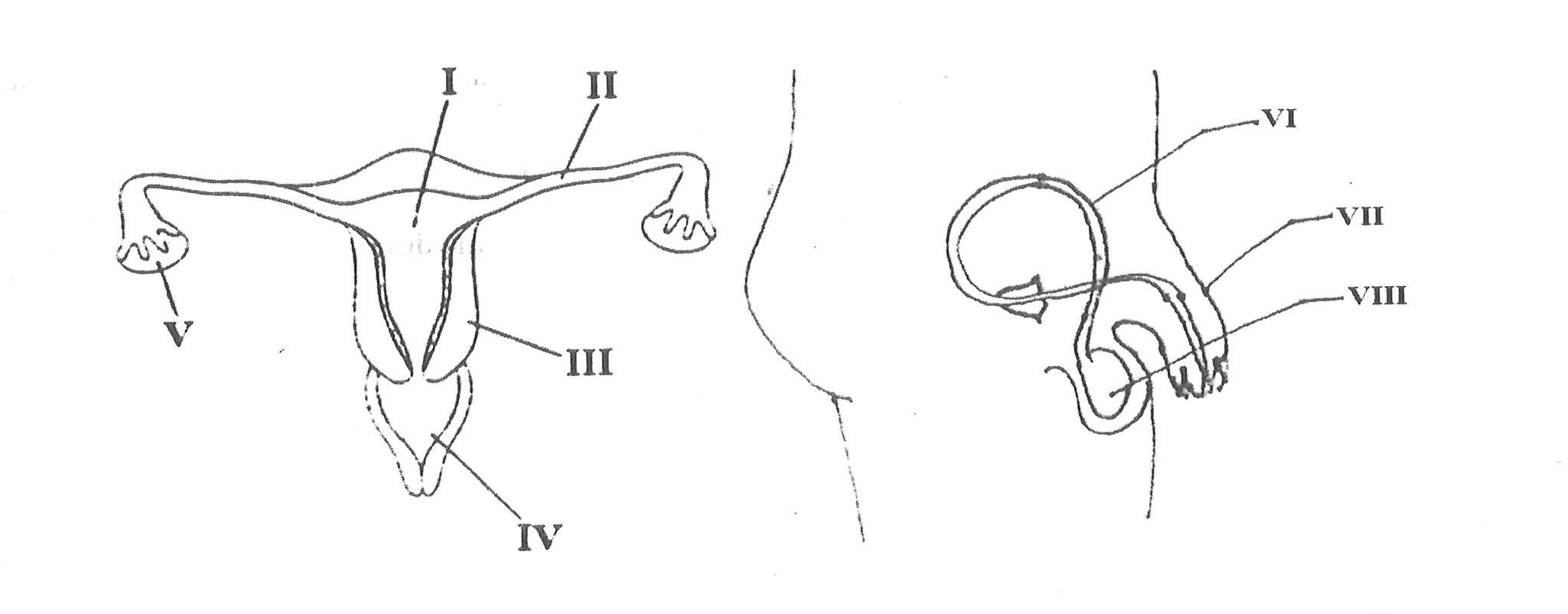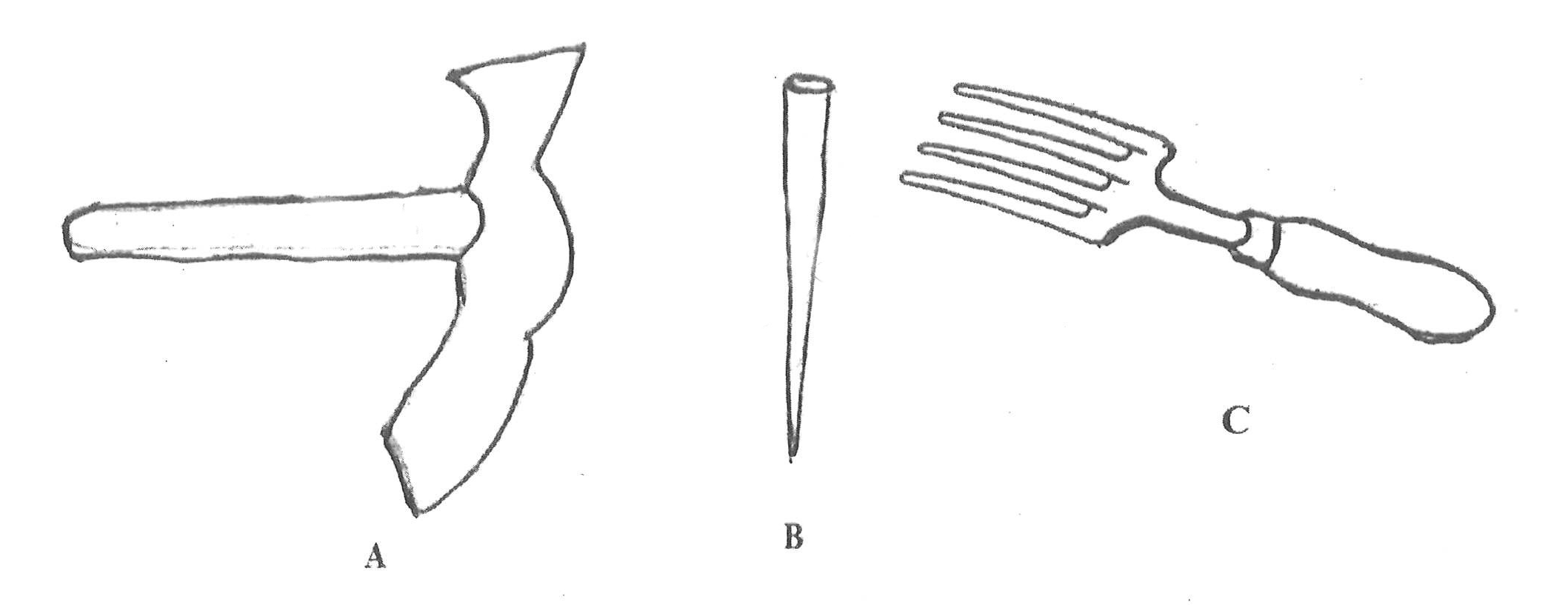1.
The very hard greenish-black deposit around the corners of the teeth is known as
gum disease.
plaque.
caries.
cavity.
2.
When equal amount of water is poured on dry soil samples, the increase in weight per unit amount of soil would be highest in
gravel.
clayey soil.
sandy soil.
loamy soil.
3.
The following practices are cultural practices in crop production except
nursing.
pest control.
mulching.
weeding.
4.
An example of a mixture is
sodium sulphate.
hydrogen chloride.
ammonia.
salt solution
5.
Which of the following statements about acids are correct?
I. They turn red litmus paper blue.
II. They can be neutralized by bases.
III. Citrus fruits contains acids.
I and II only
II and III only
I and III only
I, II and III
6.
The practice of reducing the number of seedlings per stand for better growth is known as
earthing up.
filling in.
pricking out.
thinning out.
7.
A herbal mixture has a volume of 200 m3 and a mass of 10,000 kg. Determine the density of the mixture.
50 kg m-3
200 kg m-3
800 kg m-3
10,200 kg m-3
8.
How many atoms are present in H2O2?
5
4
3
2
9.
Which of the following electronic components is not made of semi-conductors?
Capacitor
Diode
LED
Transistor
10.
Steam changes to liquid by a process called
evaporation.
condensation.
melting.
boiling.
11.
Which of the following body shapes facilitates movement in a fluid?
Rectangular
Spherical
Streamline
Triangular
12.
Stirring of soil on vegetable beds is to
I. improve aeration of soil.
II. increase activities of soil organisms.
III. increase water penetration in the soil.
IV. reduce weed growth.
I and II only
I, III and IV only
II, III and IV only
I, II and IV only
13.
The base of the N-P-N transistor normally
is a p-type semi conductor.
is an n-type semi conductor.
is undoped semi conductor.
have electrons as majority charge carriers.
14.
One benefit of technology to industrialization is
increase in cost of production.
reduction in skillful labour.
provision of machinery.
environmental pollution.
15.
Contour ploughing is normally practiced on
hard-rocky lands
muddy lands.
non-fertile lands.
sloppy lands.
16.
A pupil of mass 70 kg climbed a building of height 15 m. Determine the pupils potential energy at the top of the building.
[g = 10 m-2]
10,500 J
5,250 J
1,050 J
700 J
17.
Which of the following pairs of structures are present in animal cells?
Mitochondrion and Chloroplast
Nucleus and chloroplast
Vacuole and nucleus
Cell wall and mitochondrion
18.
Artificial satellites can be used for
I. communication.
II. oil and gas exploration.
III. meteorological studies.
I only
II only
I and II only
I, II and III
19.
The image formed by a plane mirror is always
real.
magnified.
inverted.
virtual.
20.
The following practices are principles in crop production except
land selection.
pests and diseases control.
seed planting.
harvesting and processing.
21.
Which of the following pairs of elements is in the same period in the periodic table?
5B and 13Al
1H and 3Li
4Be and 5B
11Na and 19K
22.
The daily variation of atmospheric conditions is called
climate.
weather.
season.
humidity.
23.
To test for starch in a green leaf, it is usually boiled to
isolate the starch.
kill the leaf.
make the leaf soft.
extract the chlorophyll.
24.
The following effects are as a result of soil erosion except
increase in bushfires.
weakening support of plants.
loss of important minerals to plants.
weakening of support of buildings.
25.
The following products, X,Y,Z and W have masses 0.05 kg, 50 mg, 500 g and 0.05 g respectively.
Use this information to answer the question below.
If all the products have equal volumes, which of the product (s) would have the highest density?
X
Y
Z
W and X
26.
The following products, X,Y,Z and W have masses 0.05 kg, 50 mg, 500 g and 0.05 g respectively.
Use this information to answer the question below.
Which of the products have the same mass?
Y and W
X and Y
Y and Z
X and W
27.
Which of the following ions is formed by the loss of 2 electrons?
Ca2+
S2-
K+
F-
28.
The farming system that makes the most effective use of land is
crop rotation.
land rotation.
mixed cropping.
mixed farming.
29.
An example of a natural source of light is
lantern.
moon.
glow worm.
torchlight.
30.
The SI unit that is derived is
kg.
k.
Pa.
s.
31.
The grouping together of many stars is known as
comet.
astronomy.
solar-system.
galaxy.
32.
The current in a resistor is 3A. If the resistance of the resistor is 4 ohms, determine the potential difference across the resistor.
0.75 V
1.33 V
7.00 V
12.00 V
33.
Anemometer is an instrument for measuring.
relative humidity.
rainfall amount.
wind direction.
wind speed.
34.
Which of the following statements distinguishes arteries from veins?
Arteries have relatively narrow lumen while veins have relatively wide lumen.
Arteries transport blood to the heart while veins carry blood away from the heart.
Arteries carry deoxygenated blood while veins carry oxygenated blood.
Arteries have valves while veins do not have valves.
35.
The element used in the manufacturing of electronic components is
sodium.
fluorine.
silicon.
neon.
36.
Which of the following factors has the greatest influence on vegetable crop production?
Availability of labour
Nearness to market
Source of water
Presence of pest
37.
The brightest of all the planets is
Mars.
Saturn.
Uranus.
Venus.
38.
The use of separating funnel is most appropriate for separating which of the following mixtures?
Sulphur and water
Water and sodium chloride
Vegetable oil and kerosene
Water and vegetable oil
39.
When a ray of light travels from a dense medium into a denser medium, it
bends towards the normal.
bends away from the normal.
is parallel to the incident ray.
is perpendicular to the incident ray.
40.
The two main particles in the nucleus of an atom are
neutrons and protons.
neutrons and electrons.
shells and neutrons.
electrons and protons.
a)
The diagrams below are illustrations of the male and female reproductive systems for humans.
Study them carefully and answer the questions that follow

i)
Name each of the parts labelled I, II, V, VI, VII and VIII.
ii)
State the function of each of the parts labelled III, IV and VII.
iii)
Name the labelled part where each of the following processes take place:
α)
Fertilization;
β)
Production of sperm;
γ)
Ovulation.
iv)
Name two common infectious diseases that affect both the male and female reproductive system.
b)
The diagrams below are illustrations of different devices used in the farm.
Study them carefully and answer the questions that follow.

i)
Give a common name for the devices illustrated.
ii)
Name each of the devices labelled A, B and C.
iii)
State one use of each of the devices named in (ii).
iv)
State two effects of the use of the device C on the soil.
v)
State two ways of prolonging the usefulness of the device labelled A.
c)
i)
Draw the symbols for each of the following electronic components:
α)
Resistor;
β)
(p-n junction) diode;
γ)
Cell;
δ)
Light Emitting Diode / LED.
ii)
Use the symbols drawn in (i) together with a switch to draw a circuit diagram to demonstrate forward biasing of a (p-n junction) diode and the light emitting diode.
iii)
State the effect of the resistor on the (p-n junction) diode and the light emitting diode when the circuit is closed.
d)
The following activities were carried out in the laboratory.
Study them carefully and answer the questions that follow.
I.
10 g of iodated salt was added to 150 ml of water in a baker. The mixture was stirred thoroughly.
II.
Vegetable oil was added to a quantity of water in a corked flask and shaken vigorously then allowed to stand for some time.
III.
Few grams of grinded charcoal was added to water in a beaker and stirred vigorously and then allowed to stand.
i)
State what will be observed in each of the activities I, II and III.
ii)
Suggest an aim for the experiment.
iii)
State one difference between what is observed in I and III.
iv)
State a method of separation for the activity carried out in II.
a)
i)
What is the importance of a fuse in an electrical appliance?
ii)
State two household appliances that have fuse.
b)
i)
What is teenage pregnancy?
ii)
State two causes of teenage pregnancy.
c)
State three precautions against hazards.
d)
i)
State two practices that destroy water bodies.
ii)
Give two methods of conserving water bodies.
a)
i)
What is aerobic respiration?
ii)
State the main difference between aerobic respiration and anaerobic respiration.
b)
i)
Explain the term potential difference.
ii)
The potential difference across the terminals of a 100 Ω resistor is 250 V.
Calculate the current flowing through the resistor.
c)
i)
Which crop is infected by the Swollen Shoot disease?
ii)
State the causative organisms of the disease.
iii)
State the method of spread of the disease.
iv)
Give two ways of preventing the spread of the disease.
d)
Consider the given elements: 37 X and 920 Y
i)
Write the electronic configuration for Y;
ii)
State the possible ion that could be formed by X to make it more stable.
a)
What is a neutralization reaction?
b)
State three physical properties of a soil.
c)
i)
Define the term power.
ii)
If a machine hauls a packing case of mass 50 kg up a building that is 10 m high in 30 s, calculate the power of the machine.
[g = 10 m-2]
d)
State three areas where technology is used for the benefit of humans.
a)
State three ways in which mulching restores soil resources.
b)
i)
Name the two elements that combines to form ammonia gas.
ii)
Write a balanced chemical equation for the formation of ammonia from the elements named in (i).
c)
The following information is on the feeding habits of some organisms:
i)
man feeds on grasscutter;
ii)
toad feeds on grasshopper;
iii)
snake feeds on toad;
iv)
goat feeds on grass;
v)
man feeds on hawk;
vi)
grasshopper feeds on grass;
vii)
hawk feeds on snake;
viii)
grasscutter feeds on grass.
Use all the information given above to construct a food web.
d)
i)
What is a galaxy?
ii)
State the relationship between stars and galaxies.
iii)
Explain briefly the term milky way.
a)
i)
State three effects of soil erosion on the growth of crop plants.
ii)
Mention one method of controlling soil erosion.
b)
i)
Name two science related businesses.
ii)
State the principles underlying the operation of each of the businesses named in (i).
c)
i)
Explain how the female Anopheles mosquito transmits malaria to humans.
ii)
State one chemical method of controlling mosquitoes.
d)
i)
Name two fundamental units of measurement.
ii)
State the physical quantity that one of the units named in (i) measures.